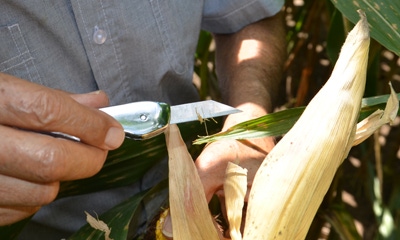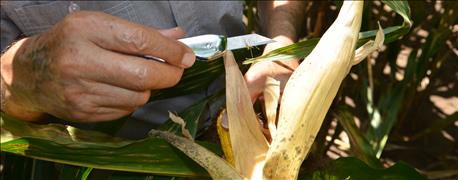
Ear rots may be coming to a field near you. That may be a surprise if you haven’t experienced a dry summer. The fact is that many other kinds of stress can cause both ear rot and stalk rot. The real question will boil down to how much ear rot is in your fields, and what kinds are out there?
Dave Nanda took a look in the Crop Watch ’16 field after one of the cooperating farmers said he saw a few ears with white husks hanging down and suspected a problem.

WHITE HUSKS STAND OUT: Other ears still had green husks and most were still upright when Dave Nanda found this ear. It’s affected by ear rot, and was located in an area with population stress.
The not-so-good news is that Nanda did find ears with white husks. The Indianapolis-based consultant for Seed Consultants Inc., sponsor of Crop Watch ’16, says at the particular stage of the season when he checked, it was difficult to determine which type of ear rot was causing the condition. He suspected it was diplodia, but he later found a few ears where he suspected two other kinds of ear rot might be at work in the field.
The good news is Nanda only found a few ears that were hanging down with white husks. In fact, he only found a few ears where he suspected some type of ear rot was at work in the entire field.
Stress matters
Where Nanda found the few ears with white husks was on end rows and in one portion of the field where the population was unusually high. In fact, a stand count on 1/1000 acre pegged it at 48,000 plants per acre.
Many people think of drought when they think of stress setting plants up for diseases, but it doesn’t have to be drought, Nanda insists. There are other kinds of stress that can predispose corn plants to problems under certain conditions later in the season.
One of those possible stressors is very high population. A population of 48,000 plants per acre in 30-inch rows means a lot of plants are crowded together, fighting for nutrients and sunlight, Nanda notes. The result can be plants under stress.
While not found in this field, soil compaction is another stress that can predispose corn plants to disease infection. The diseases can be either foliar, affecting leaves, or rots that affect the ear or stalk.
Which diseases end up in the field largely depends upon weather conditions during the growing season, Nanda says. Foliar disease came in later in the Crop Watch field, but once it did, it flourished. Warm, humid weather was favorable for gray leaf spot as well as certain types of ear rots.
The take-home message is that you should be alert to watching for ear rot and stalk rot this fall. Whether or not disease becomes important in your fields may depend upon how much stress the crop endured during the season.
About the Author(s)
You May Also Like




